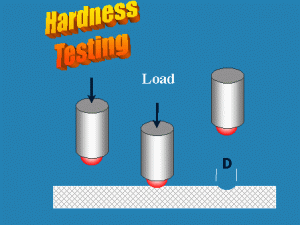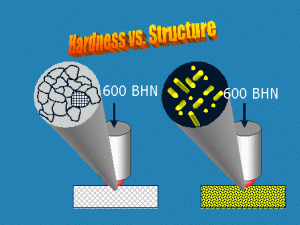Submerged Arc Welding
call us today
- 1-800-567-1362
Hardness vs. Wear
By
Robert F. Miller
Hardness is quite often used in the field of wear resistance as the criteria for judging alloys, castings, hardfacings and overlays. The premise is that the harder the material, the greater the wear resistance. While this is technically correct, applying this principal across the board can lead to some catastrophic results. For example, a Tool Steel and Chrome Carbide Iron with the same 600 BHN hardness will differ in an abrasion application by as much as 5 times. Why is this?
Let’s take a look at the hardness test to find some answers. The figure above depicts the typical hardness test. Basically an indentor made of hardened steel or diamond is penetrated into the material under a given load and acceleration. After withdrawal of the indentor the diameter or the depth of the impression is measured and reported as a relative number such as Brinnel or Rockwell B, or Rockwell C, etc. The size of this impression is quite a bit larger than any of the individual grains or hard particles. Essentially this hardness test is measuring the average hardness of many particles. It’s possible to think of this test as a Macro Hardness test. A Micro Hardness test on the other hand measures the individual hardness of each grain or particle.

How does this apply to the Tool Steel and Chrome Carbide Iron? Well, the Tool Steel is made up of approximately equal grains with all the same Micro Hardness and consequently returns the same level of Macro Hardness (600 BHN). This is illustrated on the left side of the following drawing.

Chrome Carbide Iron however consists of very hard particles (1200 BHN) of Chromium Carbide embedded in a very soft matrix (200 BHN). The individual Micro Hardness values of the hard Carbide and the soft matrix combine to yield a Macro Hardness of 600 BHN also. This is shown at the right in the above graphic. Thus it has been demonstrated that two materials can have the same hardness value and be completely different in structure.
Now let’s look at abrasion resistance. Let’s assume that the material that is doing the abrading has a Brinell hardness value of 750BHN. Since it is harder than the Tool Steel (600BHN) it will wear the Tool Steel down in short order. Conversely, since the Chromium Carbides in the Chrome Carbide Iron are very much harder (1200BHN) than the abrading particles, the wear resistance of the Chrome Carbide Iron is much greater.
From the foregoing, it becomes apparent that choosing materials to resist wear based on hardness alone, and in particular, Macro Hardness values, can be very risky. It is essential to understand the materials microstructure to establish abrasive wear characteristics. Predicting abrasive wear within a family of materials with like microstructures is much safer. In this latter case, an increase hardness almost certainly leads to increased wear resistance.
There are a number of standard Hardness tests that are commonly used. Each has it’s own characteristic method of measuring the hardness and each has it’s own scale. The table below shows a cross index of the Rockwell C and Brinell hardness scales.
Rockwell & Brinell Cross Index | ||
Rockwell (Rc) | Brinell (BHN) | |
20 | 226 | |
25 | 253 | |
30 | 286 | |
35 | 327 | |
40 | 371 | |
| 421 | |
| 475 | |
| 546 | |
| 613 | |
| 739 | |
The table below illustrates the hardness of some common materials. It should be noted that the (*) denotes another scale known as the Vickers Hardness Scale. This is a microhardness which is used to measure very small microstructures of materials. The Rockwell and Brinell tests are too large to measure these fine structures. The Vickers scale is very close in relative numbers to be used as a comparison.
Typical Hardness Values for Common Materials
Material
Brinell Hardness
Pure Aluminum
15
Pure Copper
35
Mild Steel
120
304 Stainless Steel
250
Hardened Tool Steel
650/700
Hard Chromium Plate
1000
Chromium Carbide
1200*
Tungsten Carbide
1400*
Titanium Carbide
2400*
Diamond
8000*
Sand
1000*
* Vickers Hardness
Reprinted Article courtesy of cladtechnologies.com
Reprinted Articles courtesy of cladtechnologies.com & fabricator.com
Cladded Wear Plates in Mining Applications
Hardfacing in your everyday life
We Manufacture:
All of our welding tips are made from the highest quality ISO Extruded Tubing.
Schedule Your FREE Trial
in North America
Superior Consumables product is backed by proven, documented test results.
For All Your Mig Welding Needs!
